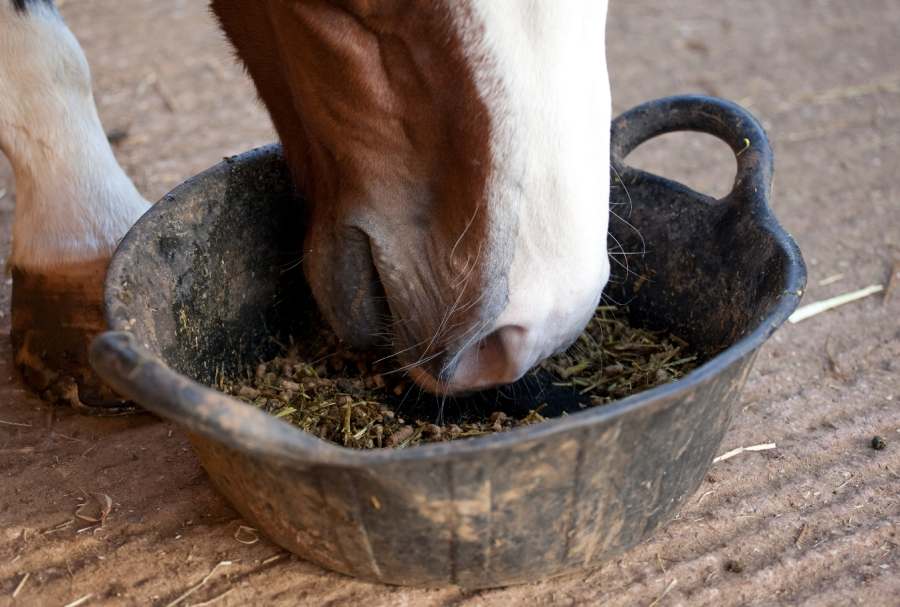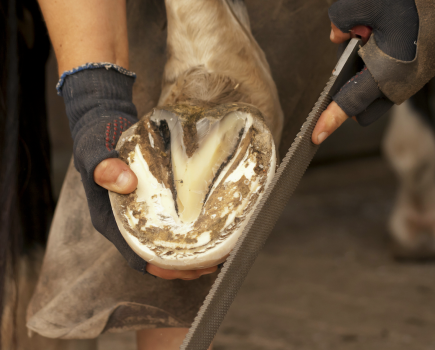An increasing number of horse owners are concerned about good doers and/or overweight horses being diagnosed with gastric ulcers, breaking the stereotype that only ‘skinny’ horses are ulcer prone. According to data released by Dengie, the feed company received a higher number of calls about this topic to its feed helpline last year compared to previous years and it was the third-highest topic asked about in 2023. How to feed a horse to promote condition safely was the most enquired about subject relating to horse diet, ahead of how to provide sufficient fibre for good doers without resulting in weight gain.
“Although horses with gastric ulcers were historically thought to typically be underweight or poor doers, this is no longer the case,” confirms Dengie feed advisor Katie Evans. “A recent study in Belgium showed that only half of horses with ulcers were underweight. Feeding too little fibre can increase the risk of ulcers, but it can be a difficult balance with good doers to provide enough but not too much forage in the diet to avoid weight gain.
“We would suggest feeding 1.5% of the horse’s bodyweight on a dry matter basis. Soaking hay and feeding less digestible fibre sources such as straw can also be beneficial to provide a lower calorie forage,” continues Katie. “Research has found alfalfa to be the most beneficial fibre source for buffering acidity in the digestive tract so this can be a useful ingredient to the ulcer-prone horse.
“Picking a feed which combines alfalfa with less digestible ingredients such as straw can be very beneficial for a good doer prone to ulcers as they will still get the buffering and quality nutrients from the alfalfa, but the straw will provide extra fibre and chew time, while bringing the overall calorie level of the feed down.”
Cereal is ‘key risk factor’ in gastric ulcers
More than 15% of callers sought advice about improving their horse’s condition safely, with a high proportion keen to avoid or reduce the amount of cereal their horse was eating and choosing feeds high in fibre and oil instead.
“Cereal is such a key risk factor for issues such as gastric ulcers,” explains Katie. “Providing calories from digestible sources of fibre such as alfalfa and sugar beet rather than starch reduces the risk of exuberant behaviour and is also healthier for the horse’s digestive system.”
A study recently published in the Journal of Veterinary Science showed that a high-fibre feed which included alfalfa and sugar beet had a protective effect for horses against the recurrence of gastric ulcers following treatment with omeprazole (*1).
“Oil is also a useful addition as it is very energy dense and so can support horses in work but it doesn’t contain starch, unlike cereal-based feeds and so doesn’t increase the risk of behavioural issues. A couple of studies (*2&3) have compared fibre- and oil-based diets with those based on cereals and found that horses were less reactive to novel stimuli when fed fibre and oil.”
Equine metabolic syndrome: enquiries rise
The number of feeding enquiries relating to equine metabolic syndrome (EMS) increased by a third compared to 2022, and was three times higher than the number of calls to Dengie about the same topic in 2020.
“When feeding the good doer or overweight individual, we want to think about restricting the calories going into their diet, while still ensuring they are getting enough fibre to keep their digestive system healthy,” explains Katie. “Less digestible fibre sources such as straw can be particularly useful to keep fibre intake up but calories to a minimum. For horses with EMS or those prone to laminitis, we also want to keep sugar and starch intake to a minimum — less than 10%.
“Soaking hay and restricting grazing will have the greatest impact on reducing sugar and calories in the diet as they make up the majority of most horse’s rations,” continues Katie. “Feeding a balancer or vitamin and mineral supplement designed for good doers will ensure the horse is getting the vitamins and minerals they may be lacking in their diet, while keeping the calorie intake to a minimum.”
Advice for how to extend or replace a horse’s hay and feeding fibre to horses with dental issues were issues four and five on Dengue’s top five topics list in 2023.
Main image credit: Shutterstock
*Further reading
- The effect of feeding a commercial feedstuff on gastric squamous gastric disease (ESGD) healing and prevention of recurrence. – ScienceDirect
- Changes of the hindgut microbiota due to high-starch diet can be associated with behavioral stress response in horses – PubMed (nih.gov)
- The effects of a high-starch or high-fibre diet on equine reactivity and handling behaviour — SRUC, Scotland’s Rural College









